Search Results
Filter by Topic
How to Apply For a Green Card
This article explains the different ways to apply for a green card.
Green Card Application
Updated: May 12, 2022
For Español click here.
Getting a Green Card means you have been authorized to live and work in the United States on a permanent basis.
In addition to living and working in the U.S. permanently, there are numerous other benefits of getting a green card:
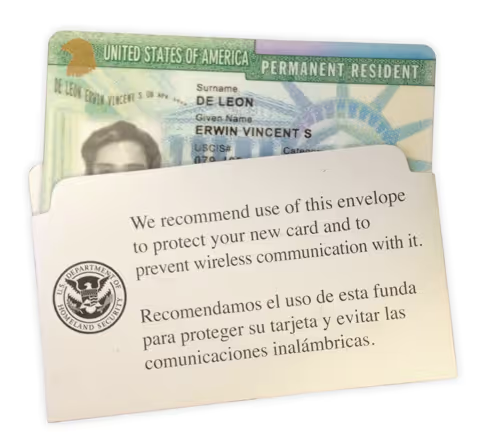
- You can now sponsor family applying for their own green cards.
- You may travel outside the U.S. and return without disrupting your status.
- Once you've had your green card for five years, you may apply to become a U.S. citizen.
- You are eligible to receive Social Security benefits after 10 years of work.
- You qualify for in-state tuition.
How to Become a Permanent Resident
There are a few different ways you may become a green card holder:
- Sponsorship by a family member in the United States.
- Sponsorship by an employer's offer of permanent employment in the United States or through your own entrepreneurship.
- Through attaining refugee or asylee status or through another humanitarian program.
To qualify for a green card, you must fall into one of the available immigrant categories.
Available Immigrant Categories:
- Family-based
- Job or employment-based
- Based on refugee or asylum status
a. Family-Based
You may qualify for a green card if you are:
- An immediate relative of a U.S. citizen. This includes spouses, unmarried children under the age of 21, and parents of U.S. citizens age 21 or older.
- Another family member of a U.S. citizen. This includes unmarried children over the age of 21, married children of any age, and brothers and sisters of U.S. citizens age 21 or older.
- A family member of a lawful permanent resident. This includes spouses and unmarried children of the sponsoring lawful permanent resident.
If you fall into one of the above categories, you can learn how to prepare a family-based green card application with SimpleCitizen here.
In addition to the above categories, being a member of another special category may qualify you to get a green card based on family. These include being a:
- Battered spouse or child
- A K nonimmigrant
- A person born to a foreign diplomat in the United States
- A V nonimmigrant
- A widow(er) of a U.S. citizen
Important to note: There is an order of preference for people who wish to immigrate to the U.S. based on family. First preference goes to the first category listed above, immediate relatives of a U.S. citizen. To see the complete order of preference for family members, visit the USCIS website.
b. Job or Employment-Based
You may qualify for a green card based on a job offer or your plans to invest in the U.S. economy and create jobs. The employment-based category includes:
- Green card through a job offer. This is also known as sponsorship through an employer — in other words, when an employer sponsors your green card application.
- Green card through investment or entrepreneurship. Immigrant investors/entrepreneurs who are investing in a U.S. - based business that creates new U.S. jobs may be eligible for a green card.
Green card through special categories of jobs. You may be able to get a green card based on having a past or current job in one of the following special categories set forth by the U.S. government:
- Afghan/Iraqi translator
- Armed forces member
- Broadcaster
- International organization employee
- Iraqi who assisted the U.S. government
- Afghan who assisted the U.S. government
- NATO-6 Nonimmigrant
- Panama Canal employee
- Physician National Interest Waiver
- Religious worker
c. Refugee or Asylum Status
You may be able to get a green card through your status as a refugee or asylee.
- If you're a refugee, the law requires you to apply for your green card within a year of entering the U.S.
- If you have been granted asylum in the U.S., the law requires you to apply for your green card within a year of asylum status being granted.
Filing an Immigrant Petition
If you belong to one of the above categories, next you will need an immigrant petition filed on your behalf. The petition establishes the basis for your immigration and the classification or category in which you belong.
- For people immigrating based on family, the petitioner will file Form I-130, Petition for Alien Relative. Click here to start a family-based petition.
- For people immigrating based on employment, the petitioner will file Form I-140, Immigrant Petition for Alien Worker
How to find out if you are eligible to apply
Everyone who wishes to get an immigrant visa (and apply for any subsequent status adjustment) must prove that they are eligible for admission to the United States.
What would make someone inadmissible? The grounds of inadmissibility are set by Congress and are particular to the category under which you are immigrating. These factors include:
- Financial reasons. The relative who sponsors you must be able to support you.
- Health-related reasons. You cannot have a disease that makes you a public health risk.
- Immigration history. If you've ever entered the U.S. illegally or overstayed a visa by six months or longer, you may be deemed inadmissible.
- Criminal history. Applicants who have been charged and/or convicted of certain crimes, such as violent felonies, drug offenses and terrorism, may be deemed inadmissible.
SimpleCitizen's Eligibility Quiz
In order to make sure you are eligible to apply and that you choose the correct application for your situation, you can use SimpleCitizen's free eligibility quiz here.
By answering just a few easy questions you can determine if you are eligible to apply. Here's how it works:
If you have a questions about your eligibility or are unsure how to get started, here are a few options:
Sign up for SimpleCitizen & take the guesswork out of the Green Card process
You don't have to try to navigate the green card process yourself, and you don't have to pay outrageous attorney fees. SimpleCitizen's easy to use software will guide you through the whole green card application.
Apply for a green card at the fraction of the cost of using an attorney — with all the comfort of having a guide along the way.
Your American dream awaits you, and SimpleCitizen can help you achieve it.
Click here to start your application.
Best Non-Profits for Immigration Help
Nonprofits that have proven results in facilitating a better experience for immigrants in the US.
General Immigration Information
Last Updated: January 15, 2025
Here at SimpleCitizen we provide immigrants with tools and expertise in order to make your status goals here achievable. Of course there many organizations that recognize the value of welcoming those that share the American dream. In order to give you the necessary tools to accomplish you goals, here are descriptions of nonprofits that have proven results in facilitating a better experience for immigrants of America.
In no particular order...
Refugees
International Rescue Committee - Better Aid

The world’s more than 60 million displaced people, the highest number ever recorded, require more than “aid as usual.” Their growing and increasingly complex needs mandate a transformation—a creative rethinking—in the global humanitarian response. The International Rescue Committee has taken on this challenge.[/caption]
The IRC works all around the world with a wide variety of issues, in the United States alone the IRC helped resettle 13,400 refugees in 2016. They have a very holistic approach to resettlement, primarily focused on immigrants that are fleeing a crisis. The IRC was started 80 years ago by Albert Einstein, whose genius seems to have penetrated the organization to this day. Fast Company claims that "...none that can rival its ability to help refugees and displaced people at every stage, from emergency response to resettlement..."
With such a wide variety of help across the entire nation, the IRC is one of the top resources for refugees. You can get the contact info of branches all over the world here. It'd be impossible to go over all the services they offer in this article, but you can take a look at what they do in Education, Health, Economic Wellbeing, Empowerment, Safety and Gender equality on their website. Did we mention they have a very holistic approach? And if you want to join the cause, they also have a variety of volunteer and internship opportunities.
Deportation
For those threatened by deportation it can feel like such a life-changing event is completely out of your hands. Both United We Dream and Families for Freedom are committed to giving immigrants the tools to empower those in the face of deportation.
United We Dream - Immigrant youth building a movement for justice
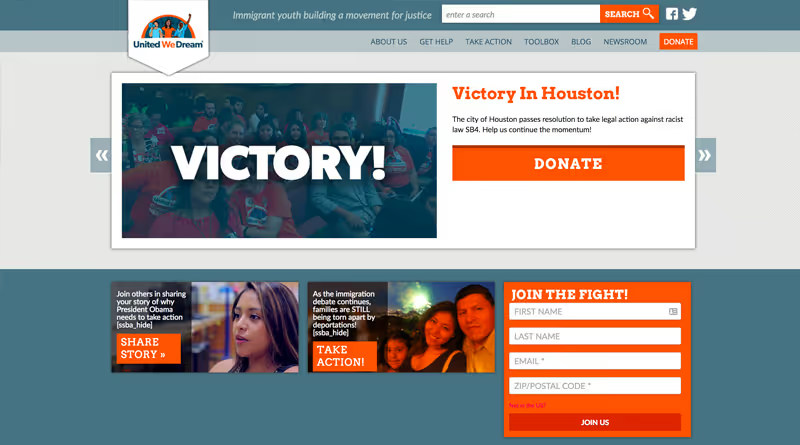
Over 100,000 immigrant youth and allies. Fifty-five affiliate organizations. Twenty-six states. Oh, and its a youth-led organization. United We Dream has a huge network that they use to run immigrant-related political campaigns like stopping deportations and access to higher education. They have even branched into the "intersection of queer and immigrant rights." If any of these issues are relevant to you, then you can Get Help! You can also find a local group to participate in here.
Whether there is a local group near you or not, United We Dream has provided a Toolkit to help immigrants all over America. Their website includes an ICE activity reporting hotline as well as Deportation Defense Cards that you can download in multiple languages. They recommend that if you feel threatened by deportation to keep the card with you at all times.
Families for Freedom - "As long as deportations and unjust immigration policies continue we will continue to fight to keep our families together"
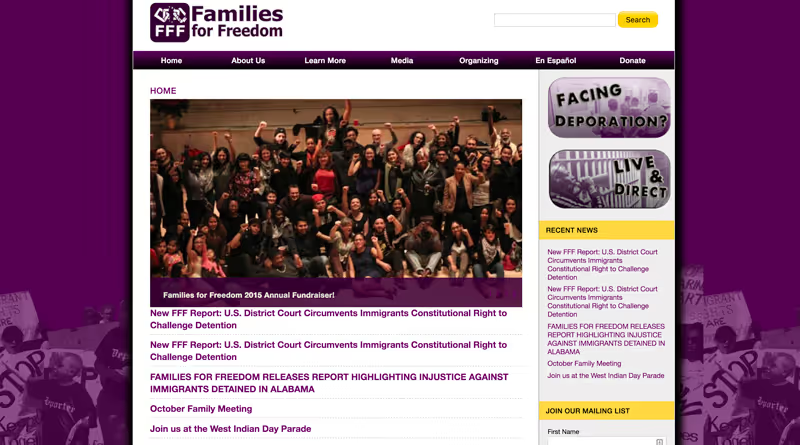
Founded in September 2002, Families for Freedom is a New York-based multi-ethnic human rights organization by and for families facing and fighting deportation.[/caption]
FFF started in response to the persecution to the often unmentioned victims of 9/11, when the wave of fear that followed one of America's greatest tragedies became directed to innocent Arabs and Muslims. FFF started with three families in a small apartment, you can read their powerful story on their The History of Families for Freedom page. Although initially FFF was focused on helping Arabs and Muslims, they have since expanded their net to include all immigrants. Like United We Dream, FFF has resources for understanding deportation threats, how to behave when your are threatened by deportation, understanding your rights, and a deportation hotline as well.
Both of these nonprofits are a powerful example of grassroots mobility and the power that average people with with a unified cause. If you feel threatened by deportation, start becoming familiar with their tools today.
Community Resources and Integration
Moving into new communities as an immigrant is full of challenges. Welcoming America and the U.S. Committee for Refugees and Immigrants use their vast network to support immigrants and the organizations that want to greet them in America.
Welcoming America - Building a Nation of Neighbors
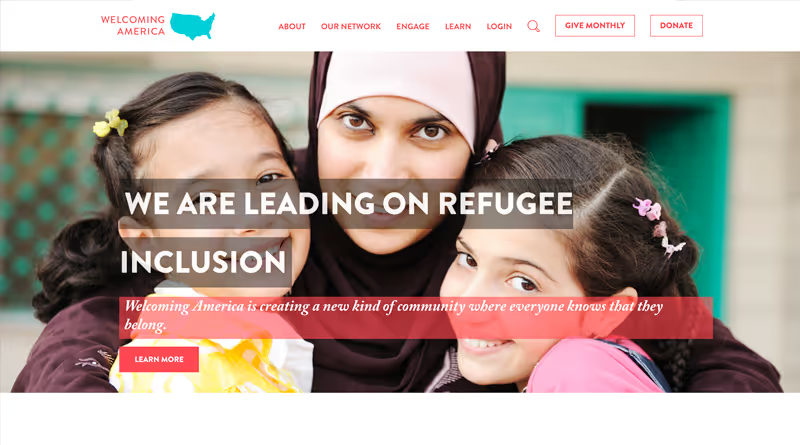
Welcoming America began after founder David Lubelli's method for transforming the community mindset in Nashville began being copied other parts of the country. After realizing the potential of the the strategy he had implemented, David first went to Harvard for a year to study policy and social psychology, and to perfect his method. Then came Welcoming America, a platform to make the communities more "fertile" for welcoming immigrants. David recently got the Charles Bronfman Prize, and you can be rest assured any organization found on their Network Map will have been trained to fully support your integration in the community.
U.S. Committee for Refugees and Immigrants
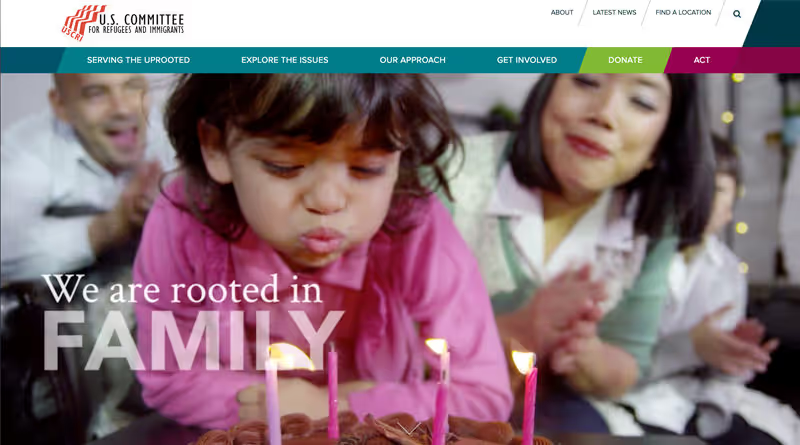
Founded in 1911, the U.S. Committee for Refugees and Immigrants has deep roots in watching over vulnerable immigrant communities. Their rich history and commitment to providing homes for the needy has made them a leader in determining what needs to be facilitated to help immigrants be successful in America. This makes both the Committee's own offices and their partners a trusted resource. For the four offices in New York, Iowa, Virginia, and North Carolina, some of the services they provide include:
- Naturalization
- Asylum
- Special Immigrant Juvenile Status (SIJS)
- Family-based Immigration Petitions/Applications
- Consular Processing
- Adjustment of Status Applications
- Work Authorization
- Green Card Renewal Applications
- Self-Petitions for Battered Spouses and Children (VAWA)
- Temporary Protected Status (TPS)
- T Visa (victims of human trafficking)
- U Visa (victims of crime)
- Removal of Conditions to Permanent Resident Status
- Removal Proceedings
Of course their network of 97 partner organizations is another valuable asset. You can view their agency map here.
Immigrant Rights
American Immigration Council - Honoring our Immigrant Past, Shaping our Immigrant Future
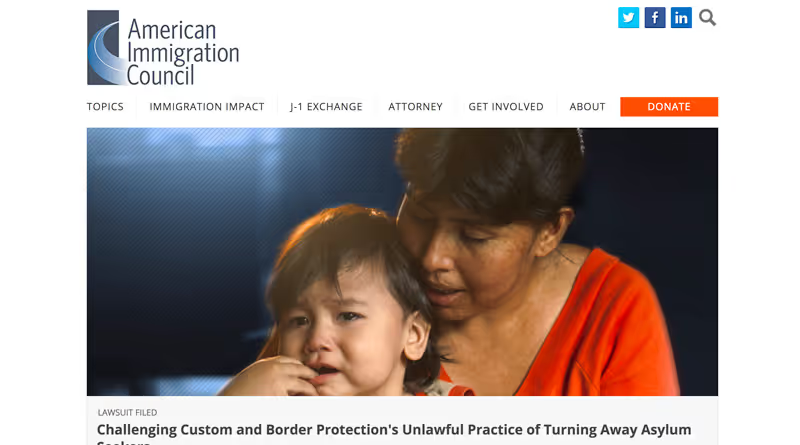
Shaping our immigrant future.
Hopefully you will never need the American Immigration Council's direct services. As one of the heavy hitters among immigration litigation, they deal in the most critical immigration cases that shapes how the country interprets immigration law. In fact, they are so important that they will never resort to shortening their name in an acronym, instead referring to themselves as "the Council."
The Council has done a lot of good for the rights of immigrants. They are a nationwide fearless defender of fair interpretation of the law. When government agencies neglect or oppose their duty to uphold immigrant rights, the council will not hold back punches. You can read a Washington Post article about the Council's law suit against top U.S. officials including Homeland Security Secretary John F. Kelly here. In a time where the norms of government are being disrupted left and right, the American Immigration Council serves as a nonpartisan advocate for respect and accountability in immigration law.
In addition, the Council provides of valuable research to inform the public with their website http://immigrationimpact.com. It's a great resource for staying up-to-date on immigration news and developing issues. In their own words "The Council is a national leader in challenging the myths and misinformation that too often dominate the political and public debate around immigration." Finally, the Council has an Exchange Visitor Program which utilizes the J Visa sponsorship to enhance and promote cultural exchange.
Benefits
Immi - Understanding Your Options
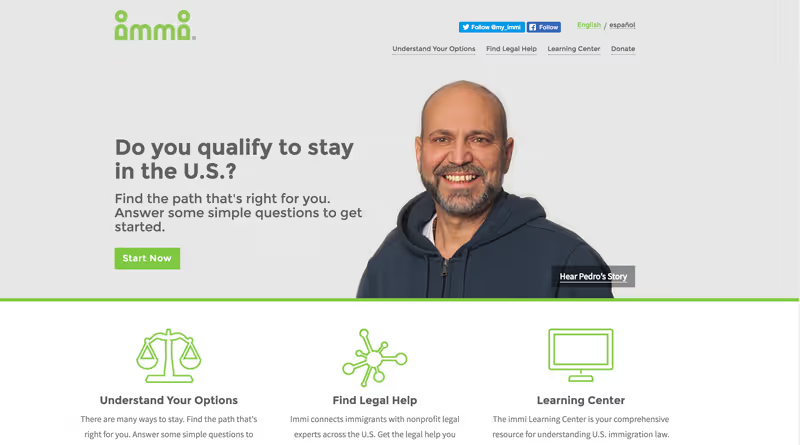
Do you qualify to stay in the U.S.? - Find the path that's right for you. Answer some simple questions to get started.[/caption]
Little know secret, being informed about your immigration options is complicated.
Ok maybe that's not a secret, and maybe it doesn't have to be complicated.
Immi's somewhat clunky slogan tells you exactly what they do. However, their online screening tool is more like the name of this innovative nonprofit - user-friendly and techy. Immi's online screening tool allows immigrants to easily gain a better understanding of their legal options. After completing the survey, your results are sent to your phone or email. Imagine, 1.5 million undocumented immigrants having access to a tool that explains what benefits they are personally eligible for.
In addition, despite being less than a year old, Immi's has one of the best immigration Learning Centers and Legal Help directories, both powered by the vast data and experience of its two parent organizations: Immigration Advocate Network and probono.net. These two organizations have partnered before on several projects, and their past working relationship allowed them to respond with serendipitous timing to the sense of urgency catalyzed by American political rhetoric.
Local organizations can be found by Immi's Legal Help tool, which provides a user-friendly search engine to find helpful organizations nearby, primarily with legal help. In addition to filtering by location, you can also narrow your search by organizations that provide the specific services you need (including non-legal), populations served and other relevant criteria. Rest assured, all non-profits found at Immi have been recognized by the Board of Immigration Appeals (BIA), or at least have staff that are included in their directory.
Honorable Mentions
HAIS
HAIS has study guides for citizen test available and subtitled prep videos in six languages: Arabic Nepali, Serbo-Crotiaon/Bosnian, Somali, Spanish, Vietnamese
Americans for Immigration Justice
A unique combination of free direct services, impact litigation, policy reform, and public education at local, state, and national levels.
Upwardly Global
They work with skilled immigrants to find employment in the United States
The Young Center
This organization upholds immigrant child rights, they have a referral function on their page if you know of an immgrant child that could use their services
What to do if you have lost your Passport
For information on how to replace your passport and visa, follow the steps outlined below.
General Immigration Information
Passports and visas are official travel documents that all foreign citizens coming to the United States must have to show one's country of citizenship and legal status in the U.S., as well as to enter and leave the country. Losing these important documents can be very stressful - here's a short guide to help relieve some of that stress and move forward.
First of all, don't worry. Your visa is needed only to enter the United States; it has no relevance to your stay here after entry. In other words, if you happen to lose your visa while already in the country, you may remain the entire length of your authorized stay (as shown on your admission stamp or Form I-94, Arrival/Departure Record) without any problems. You will, however, need a valid passport to depart the United States and enter another country. For information on how to replace your passport and visa, follow the steps outlined below.
Search
Make sure your passport/visa are actually lost and not just misplaced. Search your home, luggage, wallet/purse, and anywhere else you may have stored them. Ask family members and travel partners if they have any knowledge of the documents' location.
File a Police Report
If you still cannot find your passport/visa, go to your local police station and report your document(s) lost or stolen. If you have copies of the original documents, bring them with you. You will then be issued a police report detailing the incident. Make a copy of the report for your own records.
Report Loss of Your Passport
Contact or visit your country's embassy or consulate in the U.S. to notify them of your missing passport and for instructions on how to obtain a new one. If you think your passport has been stolen, reporting this will help guard against fraudulent use. It is extremely important that you perform a thorough search before you report it lost or stolen, because once reported, your passport is no longer valid for travel. However, if you find your passport after having reported it lost or stolen, it may still be used as a valid form of personal identification.
- If you do not have another form of photo identification, contact your country's embassy/consulate to find out what alternate documents you may need.
Report Loss of Your Visa
To report your visa lost or stolen, email the U.S. Embassy or Consulate outside the United States that issued your visa. Go to the U.S. Embassy or Consulate website to locate the corresponding email address and contact information. Be sure to include your full name, date and place of birth, current address in the United States, and your email address. Clarify whether your visa was lost or stolen, and if you have a copy of it include it in the email. If you know the category of visa you have or your passport number, include these too.
Like your passport, if you have already reported your visa as lost or stolen to the U.S. Embassy or Consulate but later find it, your visa will be invalid for future use, and you will have to apply for a new one.
Applying for a Replacement U.S. Visa
For future travel into the United States, you will need a new visa. Unfortunately, lost or stolen visas cannot be replaced in the United States. For replacement, you must apply in person at a U.S. Embassy or Consulate abroad. When you apply for a visa replacement, you will need:
- A written account documenting the loss of your passport and visa
- A copy of the police report
A Few Things to Keep in Mind
- Again, you won't have any problems remaining as long as originally authorized, but you will need a new passport before you return home. The replacement process can take time, so begin as soon as possible to ensure that you have a new one in time for your return trip.
- Some embassies and consulates may offer faster processing procedures, so ask if them if there is a way to process the new passport quickly.
- Traveling while you wait for your new passport can be risky, so try to postpone travel plans until you receive your new passport.
- If you need to complete an I-9 for employment (employment verification form), wait until you have your new passport before processing the form.
One Last Tip
We recommend making copies of all travel documents in your possession as soon as possible after arriving in the United States. These include your passport biographic page, visa, and admission stamp or Form I-94. That way, if you do lose one or all of these important documents, the recovery/replacement process will be that much easier. Remember to stay calm, follow the procedures outlined here, and respond to all questions and embassy/consulate employees honestly and accurately - before you know it, you'll be along your way as if nothing ever happened. Safe travels!
What happens after submitting your I-751 - Petition to Remove Conditions?
What to expect after submitting Form I-751, Petition to Remove Conditions
Green Card Renewals, Replacements and Removal of Conditions
Last Updated: January 15, 2020.
The USCIS provides “conditional permanent resident status” and a two-year green card to immigrants married to a Legal Permanent Resident or United States Citizen. Those who wish to attain their status as a Lawful Permanent Resident must file the Form I-751 - Removal of Conditions Application. Now, what happens after you submit your Form I-751?
Receipt of Application
Within three weeks from submitting your I-751, you will receive a receipt by mail. This receipt will confirm the USCIS has received your form and has begun normal processing. This receipt is called Form I-797 - Notice of Action. It also serves as an extension to your conditional residence for a year while your I-751 is being processed. It will come with a ten-digit number that you can use to check the status of your application. Both the I-797 and expired green card are necessary to prove conditional residency status. You should also get an extension stamp or an I-551 stamp in your passport. You can get these from your regional USCIS office. To read more about that, check out this article. Should USCIS reject your application or need more information, they will send a Notice of Action or Request for Evidence.
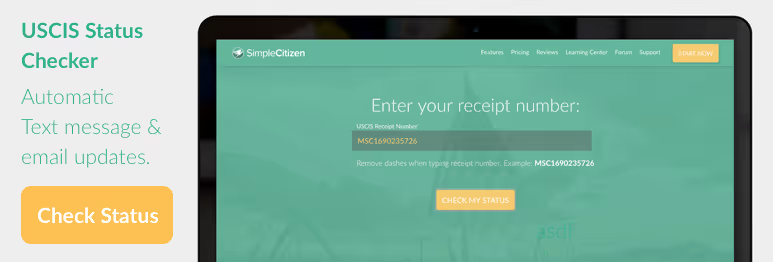
Biometrics Appointment
>> What Happens at the Biometrics Appointment?
Within four weeks of filing, you will receive a notice detailing a biometrics appointment. The notice will include the USCIS office where you will appear, the time of appointment, and the date. At your biometrics, you will record your fingerprints, photograph, and signature. (Keep in mind that although you may travel after having submitted your forms and are waiting for USCIS response, it is crucial you attend your biometrics appointment) The appointments are approximately 30 minutes, and your notice will provide details on what you will need to bring. Learn more about the biometrics appointment.
Within 5 months of your biometrics appointment, you won’t receive any further notices unless the information provided previously was unsatisfactory or needs to be re-recorded or re-submitted for any other reason.
Appointment Notice for Interview
>> How To Pass A Marriage Green Card Interview
Within 6 months, some applicants will receive an interview requirement notice. If you submit your own I-751 form, it will take 6-8 months to process; however, if your spouse submits the waiver application, it can take up to 12 months. A waiver application undergoes a more stringent screening process and often requires an interview. If the waiver application is accepted as legitimate, they will not feel a confirming interview is necessary. This is why providing valid proof of relationship (e.g. a marriage license) is important when submitting your I-751. Should you be asked to attend an interview, preparation counsel from an attorney prior to the interview is recommended. If you have used Simple Citizen and would like to schedule a call with our legal team, reach out to us at support@simplecitizen.com.
Petition to Remove Conditions granted and green card issued
Within 8 months, your application should be fully processed, and your Petition to Remove Conditions granted and green card issued. Keep in mind that the time frame is different for each form, and the entire process may take up to a year. (Remember, you can check your application’s status here.) If your mailing address changes after you’ve submitted your I-751, you should call USCIS at 1-800-375-5283 to change your record. If you feel like your form request has extended beyond the regular processing time, visit this USCIS website.
What happens at the Biometrics Appointment?
An overview of what to expect during your USCIS biometrics Appointment.
General Immigration Information
Last Updated: January 15, 2020.
The biometrics appointment sounds technical and is often intimidating for people, but it's usually a very straight-forward appointment! In order to confirm your unique identity, the USCIS collects data for many reasons, one is to ensure that whenever YOU sign a document in the future, it really is you! It also helps deter people with criminal records from applying for USCIS benefits for which they are not eligible. Here are some of the most common questions about the appointment, as well as some common problems and how to prepare for them.
What exactly does “biometrics” mean?
Biometrics is the process of capturing your unique features by putting your fingerprints, photograph, and signature on file so that the USCIS can confirm your identity in the future.
Who has to attend the biometrics appointment?
The USCIS can require biometrics from any applicant, sponsor, or beneficiary living in the US for any immigration or naturalization purposes. After filing your application, petition, or request you will receive a notice telling you where and when you need to go for the appointment.
If you are under the age of 14, you may choose to sign if you are able to, or a parent or legal guardian may sign on your behalf.
How should I prepare for the biometrics appointment?
It is a good idea to make copies of your application, petition, or request. You may bring a copy (as the USCIS will not provide you with one), but you should also do this to keep for your records and to review your forms before the appointment. Your personal appointment notice will include specific instructions on what you need to bring. Everyone MUST bring the ASC appointment notice (Form I-797C) and a valid photo ID (like a green card, passport, or driver’s license).
For most people, the biometrics appointment is nothing to be worried about! If you think you have a criminal background, you may want to contact a lawyer for further advice.
What should I expect at the biometrics appointment?
You will first be asked to reaffirm the following “Acknowledgement of Appointment at USCIS Application Support Center” statement:
I declare under penalty of perjury that I have reviewed and understand my application, petition, or request as identified by the receipt number displayed on the screen above, and all supporting documents, applications, petitions, or requests filed with my application, petition, or request that I (or my attorney or accredited representative) filed with USCIS, and that all of the information in these materials is complete, true, and correct.
If you cannot reaffirm that this is true, your appointment will be rescheduled until you can refile your paperwork.
Given that everything you submitted was true, the USCIS will capture your fingerprints (either 2 or all 10, depending on the type of ASC notice you received), your photograph, and your digital signature.
What if I am applying from outside the United States?
The process is a bit different in this case. When you file your Application for Naturalization (Form N-400) you have to include your completed fingerprint cards (Form FD-258) and two passport style pictures. For specific instructions and details regarding those, look here and here, respectively.
If you are active duty military or are applying under sections 328 or 329 of the Immigration and Nationality Act and you live outside the U.S., look here for more information.
What if I require assistance?
Many people require assistance for the appointment. Here are some of the common issues people may have, and the solutions provides by the USCIS to make this process as easy as possible.
Common Concerns
I can’t speak English.
You may bring someone with you who can translate for you.
I can’t read English.
For the “Acknowledgment of Appointment” statement, you should go here to select the language you can read and review the translation before your appointment.
I have a disability that prevents me from signing my name.
They will accept any mark (such as an “X”) as a signature. If you cannot provide this, there are other procedures in place to capture your biometrics.
I have a disability that will require further assistance.
You may bring a family member, attorney, or accredited representative to assist you.
I have a disability that will require further accommodation.
As soon as you arrive you should speak to the ASC immigration services officer for help. There are tons of accommodation services available, but you will likely need to request them in person. You can also try contacting your local Application Support Center before the appointment. Their contact information should be on your appointment notice.
Why might I have additional biometrics appointments?
Because biometrics data is only considered valid for 15 months, you may be required to attend more than one if your application is pending for longer than 15 months. You will also have to attend a new appointment should you apply for a different USCIS benefit.
What if I am uncomfortable with the government having my fingerprints and other personal data?
Unfortunately, if you refuse to provide anything that is asked of you during the biometrics appointment, your application will more than likely be refused. Biometrics are being used increasingly around the world and seem only to be gaining popularity by international law enforcement and immigration services, so you will likely be asked to provide similar levels of data to obtain a visa or green card in most countries.
Request for Evidence (RFE)? What To Do
What is a Request for Evidence and what does getting a letter of Request for Evidence mean for you?
Frequently Asked Questions
Updated: October 1, 2021
What is a "Request for Evidence?"
What is a Request for Evidence and what does getting a letter of Request for Evidence mean for your application?
The letter means USCIS needs more information to process your application. RFEs are fairly common but are serious in nature. They must be responded to in order to keep your application on track. But don't worry, getting an RFE does not mean your case is denied and preparing a response can be fairly simple. Keep reading to learn what to do if you receive an RFE.
What happens if I get a Request for Evidence?
USCIS will send a letter to the address you've provided that explains what additional information they need from you in order to move forward with your case. For tips to avoid an RFE click here.
The RFE will have a deadline. You must respond by the deadline. This deadline is usually in the first paragraph and in BOLD. The typical time to respond is about 87 days, but USCIS will sometimes give a specific date or timeframe for you to respond.
Example: An RFE may say something like, “you must submit the information within 87 days”. Treat this timeline seriously and do not delay submitting the necessary information or evidence that they are requesting.
When you are getting ready to send in the requested information indicated in the RFE, make sure to review the letter carefully. You must respond to all information requested at one time. USCIS will not allow you to send more evidence later. You only get one response. Make sure that you attach a cover letter explaining what you are sending in, why you are sending it in and any other information that might be helpful.
The RFE will include instructions for where to send the response. In some cases you'll need to include the original RFE letter with your response, while in other cases USCIS only requests a copy of the RFE letter. Whether you are required to send the original or the copy, attach it to the very top of your response. Make sure that it is the first page and the first thing that the USCIS officer sees when they open your application.
The RFE should include an address for you to send the response packet to. Make sure that you send the RFE response to the address listed. It will be different than the original USCIS address that you sent your application to.
Let us know
Immigration issues can be tricky. If you have any questions about your specific Request for Evidence or your immigration case, there are experienced professionals that can help.
If you are a customer of SimpleCitizen and you've received an RFE please reach out to us via live chat, email or phone. RFE responses are included with the Professional package we offer. Do not hesitate to reach out and ask for help.
Self-Employed Sponsor and USCIS Form I-864, Affidavit of Support
What you need to know about having a Self-Employed Sponsor fill out Form I-864.
Green Card Application
Last Updated: January 15, 2020.
Self-Employed Sponsor and Form I-864
What you need to know about having a Self-Employed Sponsor fill out Form I-864. One of the requirements to get a green card is having a financial sponsor file the I-864, Affidavit of Support. This USCIS form is basically a contract between the financial sponsor, the immigrant applicant and the US government. As part of the contract, the sponsor must meet certain income requirements to qualify as a financial sponsor for the immigrant. Like every form on the green card application, several documents must be submitted as supporting evidence for the information provided in the application.
Submitting supporting evidence for a sponsor that is currently employed is fairly straightforward. The sponsor needs to attach their most recent federal tax return, a letter from their employer and pay stubs for the past 6 months. These requirements become useless when the sponsor is either self-employed or retired.
Self-Employed Sponsors & Form I-864 Supporting Documents
The USCIS actually has a few guidelines when it comes to proving an income amount for a sponsor that is self-employed or a business owner. The USCIS suggests that self-employed sponsors should attach the following photocopies of documents to their I-864, Affidavit of Support:
- Total and Complete Tax Return: All schedules associated with the federal return including Schedule C (Profit/Loss from Business), Schedule D (Capital Gains/Loss), Schedule E (Supplemental Income/Loss) and Schedule F (Profit/Loss from Farming).
- Business Licenses and registrations.
- Signed and dated statement about the nature of the business and the sponsors involvement.
- Bank Statements for the previous 6 months.
Retired Sponsors & Form I-864 Supporting Documents
If the sponsor that is submitting the Form I-864, Affidavit of support is retired, a similar problem exists. Again, the goal for a retired financial sponsor is to simply provide independent evidence that establishes a steady flow of income matching the amount reported in the Form I-864. This can be accomplished by providing the following documents:
- Recent Pension Statements and Current Pension Payment Receipts
- Social Security Documents that indicate payments
- Complete Tax Returns
- Bank Statements for the previous 6 months
As you are working to complete your green card application and fill out a correct Form I-864, make sure that you are avoiding some of the other pitfalls of the financial sponsor for a green card. Making sure that you are calculating the household size correctly or including the accurate income amounts are a few of the important things to remember when working on this application. SimpleCitizen is a do-it-yourself tool to help you avoid these common mistakes. We are the only truly comprehensive service, guiding users from signup to citizenship while ensuring their application is correct and complete at every stage.
What Happens After Submitting the Form I-130?
Understanding the steps that follow after submitting Form I-130.
USCIS Forms
Last Updated Jan 15, 2020.
The I-130, Petition for Alien Relative, is the first form you must submit in order to obtain lawful permanent residence (green card) for a family member. After submitting this form, there are three key steps which must occur to receive a green card:
1. Confirmed Receipt of I-130
Within 2-3 weeks of submitting your I-130, you should receive a Notice of Action (also known as Form I-797). It is vital that you read the information on this notice, as it will tell you if your I-130 has been received, rejected, or requires more information from you. The Notice of Action will contain a priority date and a receipt number can be used to check application status.
If you haven't received a Notice of Action within a few weeks, you should make an inquiry here.
2. Approval Process of I-130
After your I-130 is received, it will be reviewed. USCIS prioritizes the review of petitions from Immediate Relatives, which comprise:
- spouses of citizens
- unmarried children (under age 21) of citizens
- parents of citizens 21 years of age or older.
USCIS issues an unlimited number of immigrant visas (green cards) to Immediate Relatives. Thus, processing time is faster for Immediate Relatives than other relatives.
Other relatives are categorized as Family Preferences:
- Unmarried children of U.S. citizens age 21+, and their minor children (F1)
- Spouses, minors and unmarried children age 21+ (F2)
- Married children of U.S. citizens, their spouses and minor children. (F3)
- Siblings of U.S. citizens, and their spouses and minor children, if age 21+ (F4)
Congress permits a limited number of Family Preference visas per year. Therefore, people who fall into this category often wait longer for a visa number to become available. Priority depends on when the I-130 was submitted. The wait time can be anywhere from 6 months to 6 or more years.
3. Filing for a Green Card
Once your I-130 is approved, you may be permitted to file for a green card and hopefully obtain lawful permanent residence. The filing process depends on relative status and where you are currently living.
Immediate Relatives:
- Inside the US: Immediate relatives inside the US can submit Form I-485 (Application to Register Permanent Residence or Adjust Status) while the U.S. citizen petitioner files Form I-130. Relatives may file I-485 applications any time after a Form I-130 has been submitted if it has not been denied, although relatives must submit a copy of their Notice of Action along with Form I-485 in order to prove that Form I-130 is in process.
- Outside the US: Immediate relatives outside the US obtain green cards through consular processing. The USCIS will work to schedule a visa interview with a U.S. consulate in the relative's country. The Department of State will notify the relative when he or she is may apply for an immigrant visa, which must be applied for within one year of this notification. Once the Department of State issues an immigrant visa, the relative may travel using the visa and will obtain permanent residency when they reach a U.S. port of entry.
[eligibility-quiz-green-card]
Family Preference:
- Inside the US: Once Form I-130, Petition for Alien Relative, is approved, one must wait for the priority date in one's immigrant visa category to become current (see the date listed in the Notice of Action, and check when it is current by adjusting the following June 2017 URL to reflect the current month and year uscis.gov/visabulletin-Jun-2017). When the date listed is current, it is time to file Form I-485, Application to Register Permanent Residence or Adjust Status. This is the required form for becoming a Permanent Resident.
- Outside the US: Family Preference relatives outside the US also obtain green cards through consular processing. See those details above.
Remember...
- In most cases, children's ages are “frozen” as the ages listed when Form I-130 was filed.
- If unmarried children of U.S. citizens get married before obtaining green cards, they may cause serious delays in processing. Children of U.S. citizens must notify USCIS of any change in marital status after submitting Form I-130.
What Happens After Filing Form I-90?
Understanding some of the steps that following submitting Form I-90 to USCIS
USCIS Forms
Last Updated: January 15, 2020.
You've just submitted your Form I-90, but you are curious what happens after submitting your form I-90. There are just a few more steps before actually receiving your new green card. Depending on the current USCIS wait times, you can expect to receive your new green card about 6-12 months after submitting your I-90. This guide outlines the post-application process, making it smooth and stress-free.
1. Receipt of Application
The first thing that will happen after submitting your I-90 is you will receive a Receipt of Application from the USCIS aka Form I-797C, Notice of Action usually takes up to 3 weeks to arrive. This means the USCIS has received your application. If the USCIS needs more information or your application has a mistake, the I-797 may have additional instructions. Follow the instructions in these letters carefully.
2. Appointment Notice
The appointment notice informs you when and where to go for your Biometrics appointment. The purpose of the Biometrics appointment is simply for the USCIS to confirm your identity and run a standard background and security check. Save the appointment notice because you will need to bring it with you along with a valid photo identification. This could be a green card, drivers license, passport or a national photo identification issued by your country. It could also be a military photo identification or other state-issued photo id card.
*Note: Its also good idea to bring a copy of your application, because they cannot provide you with one at the regional USCIS office.
3. The Biometrics Appointment
As mentioned above, the date, time and location of the Biometrics appointment will be mailed to you in the Appointment Notice. Show up to scan your fingers, sign an attestation and have a photo taken. It takes most people only 15-30 minutes.
Digital Signature
- Be ready to sign an attestation that reaffirms that on the application you provide correct information (at the time of filing). The only exceptions apply to those with certain physical impairments or mental disabilities. Otherwise you must sign. You can read more about this process here.
- If you would like, you may bring an attorney, interpreter, family or friend to stay with you throughout the process. However, even if your attorney prepared your paperwork, they are not required to attend your biometrics appointment.
Rescheduling
If you need to reschedule follow the directions in your Appointment Notice as soon as possible. If the biometric information is not fulfilled soon enough your application will be at risk of denial. After you've made a reschedule request, the regional USCIS office will assign you another date within 30 days of your reschedule request.
4. The Finish Line
Generally, the whole process takes about 6 months. If you are getting nervous you can always check the status of your application here using your application receipt number.
When your application is accepted your green card will be mailed to the U.S. address you gave the USCIS in your application. You'll also get a letter if your application was denied explaining the reason for its denial. There are two ways to get another chance if your application is denied.
- Motion to Reopen - if you have new evidence that you want the USCIS to consider with your application.
- Motion to Reconsider - this motion is if your application's denial was incongruent to law or immigration policy. This must be established based around the information that you have already submitted.
Note: You cannot file an appeal regarding your I-90 application. Meaning that there is not a way to request a higher authority to review the decision. It will be the same office that reopens or reconsiders your application.
Other Resources
- USCIS National Customer Service Center (NCSC): 1-800-375-5283. Have specific information about your application ready, including your receipt number, Alien Registration Number, name and date of birth.
- Find accredited legal help here.
- Locate an USCIS office here.
- For more information about the green card renewal process, click here.
SimpleCitizen makes software that simplifies the green card renewal process. We’ll guide you through every step of the application, and you can even have it reviewed by a professional immigration attorney. When you’re finished, we can even print out the forms and mail them to you. To get started, click here.
Undocumented to Green Card: The Real Story
Get to know Vikram Babu and the story of his journey to obtaining a green card!
General Immigration Information
Last Updated: January 15, 2020.
Medium.com featured the tell-all, behind the scenes tale of one mans struggles through life and the intimidating US immigration process.
Vikram Babu tells his story of going from Indian immigrant to Canada to undocumented alien in the US to full-fledged green card holder. His story mirrors the same plot points of millions of other families in the U.S. that find a pathway to citizenship via the green card program.
He tells the beautiful story of love found, then love lost. The mini-challenges of learning the difference between a Form I-130, Form I-485, supporting documents and the Form G-325A. A natural Do-It-Yourself inclined man, Vikram spent months putting the application together himself, following the instructions carefully. This process can be very stressful as millions of immigrants end up paying lawyers billions of dollars every year to avoid rejections or delays by the government due to a simple mistake on their application.
Vikram explains the feeling of relief as he successfully completes the green card process with the USCIS. As he establishes himself, makes progress in his career, moves to a new city, he is struggling with the same challenges that everyone faces as we navigate life, US citizen or not. He deals with the added difficulties of the anti-immigration sentiment that existed in 2009-2012 and continues on today.
Vikram's story is particularly important because most American citizens have a similar story in their family be it from their grandfather, great-grandmother or beyond. These immigration stories are not only important moments in the lives of each of these families, they have also been important moments in the story of America.
Read the entire story (10 min read) with pictures via Medium.com here

